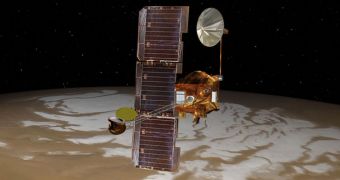On Saturday, November 28, the American space agency's oldest enduring orbiter around the Red Planet, the Mars Odyssey, put itself into safe mode. At this point, both spacecraft, the Odyssey and the Mars Reconnaissance Orbiter (MRO) are nonoperational, but NASA engineers say that the former experienced just a minor glitch, and that it will soon be reverted to its initial status. The MO team has already begun to implement a set of computer commands that will bring the spacecraft back to life in the coming days or weeks.
“Engineers have diagnosed the cause of the Nov. 28 event as the spacecraft's proper response to a memory error with a known source. The likely cause is an upset in the orbiter's 'memory error external bus,' as was the case with a similar event in June 2008. In safe mode over the weekend, Odyssey remained in communication with ground controllers and maintained healthy temperatures and power. To clear the memory error, the team commanded Odyssey today to perform a cold reboot of the orbiter's onboard computer,” a pres release on the Jet Propulsion Laboratory's (JPL) website says.
“This event is a type we have seen before, so we have a known and tested path to resuming normal operations,” the Odyssey Project Manager, Philip Varghese, from the JPL, explains. The laboratory is operated by NASA, and is based at the California Institute of Technology (Caltech), in Pasadena. The spacecraft arrived in orbit around the Red Planet in 2001, and has been performing groundbreaking science ever since. In addition to sending back numerous photos and making discoveries on the surface of Mars, it has also provided invaluable help to other NASA missions, such as the Mars Exploration Rovers (MER) and the Phoenix Mars Lander.
With their relay down, Spirit and Opportunity now have to use their individual high-gain antennas to communicate with the Mission Control, and get their new objectives. The fact that they had an intermediary in communications allowed them to retain a larger amount of electricity each sol (Martian day) until now, but now their reserves will be stretched fairly thin by the large requirements that their long-range antennas have. Hopefully, this will be remedied when the Odyssey is restored to its full function, JPL experts say.

 14 DAY TRIAL //
14 DAY TRIAL //